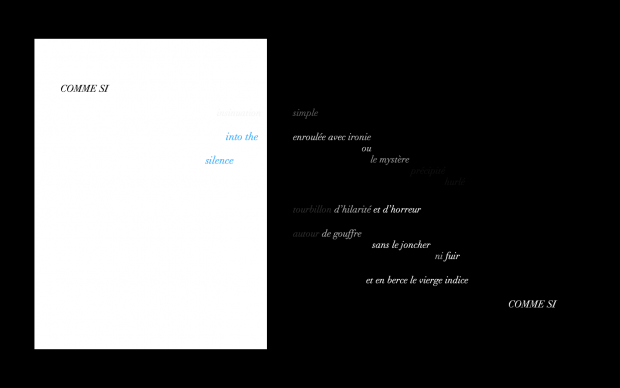Inextrinsix: Multilingual, Collaborative Digital Poems
This is a presentation with commentary of two experimental original, collaborative digital poems: one with variora in two voices; and the other somewhere between a translation and a multilingual composition in English, Italian and French. “Digital Poetry” is understood to be language-based, formally structured art to which the digital dimension is indispensable in at least one of the following elements: composition, performance, or reception. We are two published poets who have worked for many years with translation in literature. This collaboration takes us into an exploration of the continuous re-invention of the speaking Subject through traversing languages in digital space. It breaks new ground in opening on to potential poetic conversations across cultures, even where interlocutors are far from fluent in each others’ languages. It is potentially an immediate way in to the kinds of discovery that can make translation so rewarding, but that are not generally easy to access without relatively long experience, especially in a literary context. The poems in our presentation were/are being composed through an email version of the corps exquis, where we agreed some simple ground rules, and then sent each other a couple of lines at a time. The ground rules were not rigid, and we soon loosened our initial attempts to include formal frameworks such as poetic meter. The most enduring agreed rule was not to open an email until ready to read and respond, and then responding immediately. These poems form the source texts. They are being programmed by Penny in close consultation with Paolo by means of digital Readers, part of the Readers Project with which the ELO will be familiar, and within which Penny has presented several times with John Cayley. John describes the digital Readers that are the basis of the Project as “distributed, performative, quasi-autonomous poetic ‘readers’ – active, procedural entities with distinct reading behaviors and strategies”. “Inextrinsix” is the nominal form of the epithet Penny coined to characterize how she programmes the Readers. The reason we have called these digital poems “inextrinsix” is that the idea of the “inextrinsic” embodies a contradiction, or tension (“in-ex”). This is because it concerns an essential property of digital poetry, that of its capacity to go deeper into poetic language, and translation, than was possible before it (intrinsic), but also because it then moves to foreground associative, or metonymic, traces (extrinsic). To give an example of a related linguistic element: paranomasia, or punning, is a feature of much digital poetry. Punning is an inextrinsic figure because it works by taking the reader into a figure of language, the direction of which then goes outward. It is also useful as an example because it has a visual element that transposes to sound, an attribute much more foregrounded in digital poetry than in the generality of printed poetry. Lastly, it is right on the edge of consciousness, which is perhaps the most important when it comes to digital Subjectivity. To elaborate a little: innovative language is necessarily oblique in terms of what is currently known. The joke work, like the dream work, can enable perception of the unconscious or preconscious, or that in which reason or the Symbolic is embedded. This is the terrain of the speaking Subject in process, and this is where moving between natural languages in digital form opens on to new potential. The electronic, inextrinsic Readers work on this threshold. The “completed” texts on screen start with a static version of the poem, which serves as a frame, part of which remains on screen throughout. The human reader then interacts with the digital Reader by pressing specific number keys on whatever device s/he is using. These works take my earlier collaborations with John forward mainly in the following ways: they are original poems, composed collaboratively via email; translation is treated almost as part of syntax in the programming; and the same goes for multiple voices. That is, the analytic strategies according to which the movements and “Readings” traverse the source texts are treated as if there were no distinction between a change of speaker, a change of language and the kind of grammatical or structural move native to poetry. The effect, however, is to expose where they overlap and where they do not, thereby revealing a differential comparable to a partial palimpsest. Digital Reading is what creates and opens this space. (Source: ELO 2015 Catalog)


